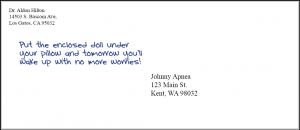

If there’s one statement, I hear almost daily, that makes my blood boil it’s: “That may work for YOUR business, but my prospects and clients too smart/sophisticated/rich to fall for such moronic tactics like a worry doll. I’m a financial planner (or dentist, or contractor…) and I just can’t see my people falling for that.”
Hopefully this example will help squelch that all together.
 It’s a letter I wrote for my client Dr. Aldon Hilton, a dentist in the San Francisco area. Yep… those smug, over-paid, over-educated, Silicon Valley elitists actually responded to and bought based on a letter with a worry doll inside (sorry Doc, I wanted to paint a vivid picture to get the point across).
It’s a letter I wrote for my client Dr. Aldon Hilton, a dentist in the San Francisco area. Yep… those smug, over-paid, over-educated, Silicon Valley elitists actually responded to and bought based on a letter with a worry doll inside (sorry Doc, I wanted to paint a vivid picture to get the point across).
In fact, they responded well to three letters using 3D Mail, this being the first in a sequence. Step 2 was a compass and step 3 was a boomerang.
You’ll want to check out the sample letter here.
Dr. Hilton isn’t your ‘normal’ general dentist, he doesn’t clean, grind and drill. He specializes in sleep retainers for patients with sleep apnea. His “avatar” patient is a male between 40 and 65, makes well into the six figures, is married, drives a nice car, drinks fine wine.
He has been kicked out of bed for snoring more times than he cares to count, and he’s spent in the neighborhood of $10,000-$20,000 to cure his sleep apnea.
This guy (actually 8 of them from a small list of about 175 past patients) responded to a series of 3D Mail letters. Each patient is worth between $5,000-8,000.
So, you tell me, are your prospects or clients still too mart/sophisticated/rich to fall for such moronic tactics? If this can work for Dr. Hilton, it will work for you.
Now that we have that out of the way, let’s take a look at the mail package. We’re targeting past patients with the letter. Most businesses don’t spend enough time marketing and selling to their current clients. Most spend 90% of their looking for new clients.
While acquiring new clients is vitally important to any business, most are too focused on it, and all but ignore their current client base. You need to spend time on both!
Since these went to past patients we used the doctor’s name in the return address. As a general rule of thumb I’ll typically use a business or person’s name, or a company logo when mailing to past or current clients. When mailing prospects, those who don’t know me, I’ll typically opt for just an address, or a person’s name and address.
a business or person’s name, or a company logo when mailing to past or current clients. When mailing prospects, those who don’t know me, I’ll typically opt for just an address, or a person’s name and address.
We also used a lived $0.70 stamp on the envelope, and a bit of “teaser” copy on the outside with a little hint of what’s inside.
Let’s move inside the envelope to the actual letter. You’ll notice right away the story in the box on the right side of the page. We place the story there for a reason. First, to explain why they received the worry doll along with the letter. Second, we know through studies of eye movements where the reader’s eyes will concentrate first. See this chart:

They start on the top left and read the headline, moving to the right. Then the eye will move down the right side, where it will stop at the Johnson box. They will then read the story of the worry doll.
The story, however short, will draw them into the letter and offer intrigue to read the rest of the letter. Why do we tell the story? Because people love stories, and the longer we keep them reading, the more invested in the letter they become, and thus we’re able to convert more readers into responders and buyers.
You’ll also notice we only gave them one means of replying, via a direct phone call to the office. Dr. Aldon has a tremendous phone protocol, and they are trained in converting a phone call to an office visit very well.
He knows his closing ratios from call-in to appointment, then appointment to sale once in the office. Those who call are much more likely to keep the appointment and show up. They are also more likely to buy after the appointment. Knowing this, all paths lead to a phone call vs. emailing or a website visit.
I also used shaded boxes and bullets to break up the copy. We also used the boxes to call out the most important aspects of the letter. Using these “copy enhancements” increase the likelihood of readership.
You need eyeballs on your piece to make a sale, and using cosmetics is a great way to do that. It also helps to keep the person reading. You’ll notice I often use a dot, dot, dot (…) style in my letters, or handwritten notes to “read more” or “over please.”
All of these help keep the person reading your letter. I also used extremely short paragraphs and sentences. No paragraph is more than 2 sentences and no more than four lines, again increasing readership.
Overall the 3-step sequence performed extremely well. Cumulatively the 3 steps brought in 12 appointments, with six converting to paying patients immediately. It’s my belief that 2-3 of the remaining six will convert as well. With a price point of $5,000-8,000, the return on investment was nearly 17:1. Not bad from a list of 175 patients.
Add Your Comments